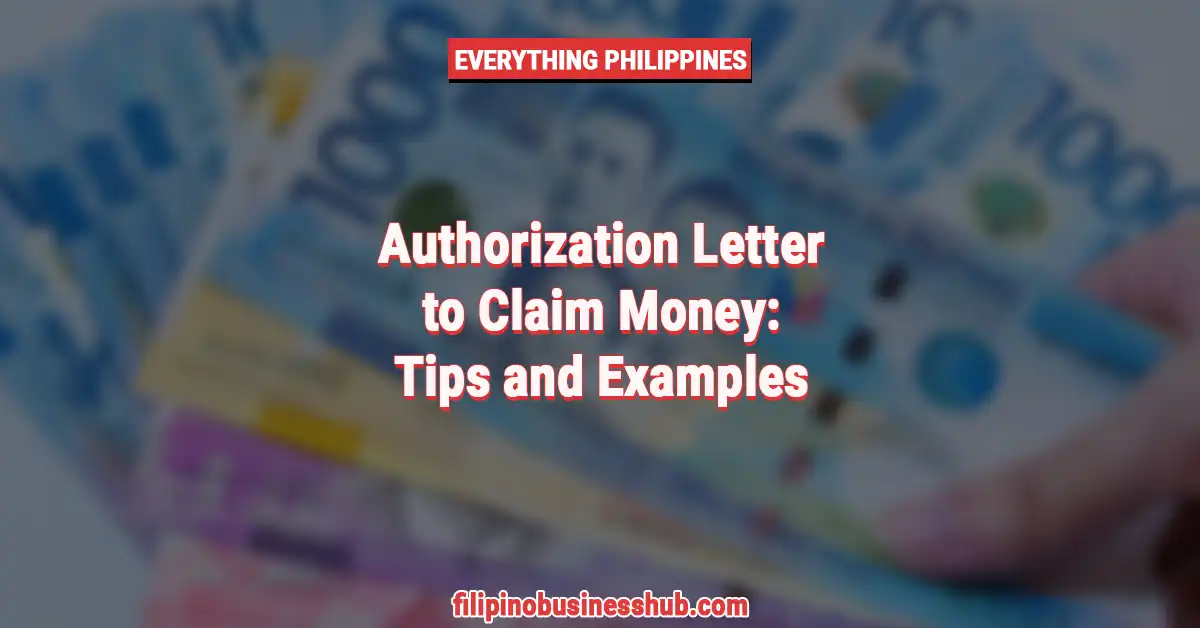Authorization Letter to Claim Money: Tips and Examples
In financial transactions, where convenience seamlessly intertwines with legal necessity, the role of an Authorization Letter to Claim Money becomes pivotal. These letters act as potent tools, bestowing individuals with the authority to claim money on another’s behalf, simplifying intricate processes. Whether you’re entrusting a family member, a friend, or a legal representative with this responsibility, crafting an effective authorization letter to claim money can be transformative. This article delves into the profound significance of authorization letters in the context of money claims. Moreover, we’ll provide invaluable tips and real-world examples that empower you to compose an authorization letter to claim money that elegantly balances legality and practicality.
Table of Contents
Invaluable Role of Authorization Letters in Money Claims
The need for authorization letter to claim money arises from convenience and legality. These letters act as formal endorsements, granting designated individuals the authority to act on behalf of the claimant in financial matters. Imagine scenarios where a family member needs to collect a refund from a vendor, a friend is helping you retrieve a payment, or a legal representative is claiming settlement funds – in each case, an authorization letter to claim money becomes the bridge between the claimant and the appropriated.
Article Objective: Crafting Effective Authorization Letters for Money Claims
The objective of this article is simple yet powerful: to equip you with the knowledge and tools to create authoritative and persuasive authorization letters for claiming money. We’ll delve into the intricacies of a well-structured authorization letter, providing essential tips that ensure legal compliance and clarity of intent. Moreover, we’ll explore real examples that illustrate these principles in action, offering you a practical understanding of how to adapt these insights to your unique situations. By the time you’ve reached the end of this article, you’ll possess the skill set needed to draft authorization letters that not only navigate the bureaucratic landscape but also stand as compelling documents to facilitate efficient money claims.
Understanding Authorization Letters for Money Claims
Definition and Purpose of an Authorization Letter to Claim Money
An authorization letter to claim money is a formal document in which an individual, known as the claimant, grants authority to another person or entity to act on their behalf in specific financial matters. It’s a legally recognized instrument that enables seamless execution of transactions without the claimant’s physical presence. The purpose of such letters goes beyond mere convenience; they are essential tools in situations where physical distance, time constraints, or other reasons prevent the claimant from personally conducting financial tasks.
Why Authorization Letters Are Needed for Claiming Money
Claiming money often involves several procedural steps, including verifying identities, presenting necessary documents, and adhering to financial institution protocols. An authorization letter bridges the gap in scenarios where the claimant cannot be physically present. It ensures that the designated person or representative is empowered to fulfill the necessary tasks on the claimant’s behalf, backed by the legal weight of the authorization.
Legal and Practical Aspects of Using Authorization Letters to Claim Money
- Legal Validity: Authorization letters are valid when drafted in compliance with relevant laws and regulations. They must clearly outline the scope of authority granted, the tasks permitted, and the authorization duration. Incorrectly or vaguely worded letters may lead to disputes or denied claims.
- Explicit Intent: An authorization letter to claim money must explicitly state the claimant’s intent to delegate authority. This clarity helps prevent misunderstandings and ensures the authorized party knows their role and responsibilities.
- Signature and Notarization: Depending on the nature of the financial transaction and local regulations, authorization letters require the claimant’s signature and, in some cases, notarization. These measures add a layer of authenticity and enhance the letter’s legal weight.
- Personal Information: An authorization letter typically includes personal information about the claimant and the authorized individual. This ensures the financial institution or entity can verify identities and carry out the transaction securely.
- Limitation of Authority: An authorization letter should clearly state the specific actions the authorized person can take to prevent misuse. This avoids potential issues arising from overstepping the granted authority.
Understanding the interplay between the legal and practical aspects of authorization letters is essential for creating notes that fulfill their intended purpose and adhere to the appropriate regulations.
Continue reading to explore the critical elements of an effective authorization letter, offering guidance on structuring your letter for maximum impact and clarity.
Key Elements of an Effective Authorization Letter to Claim Money
Crafting an effective authorization letter involves careful consideration of its key components. These elements ensure legal compliance and contribute to the overall clarity and efficiency of the letter.
1. Clear Identification of the Parties Involved
Begin the authorization letter by identifying the claimant and the authorized individual. Provide their full names, addresses, and any relevant identification numbers. This ensures that the financial institution or entity can accurately verify the identities of those involved.
2. Specific Details About the Purpose of the Letter
Be explicit about the purpose of the letter, which, in this case, is claiming money. State the reason for the authorization, such as retrieving a refund, settlement funds, or any other specific financial transaction.
3. Date and Duration of the Authorization
Include the exact date on which the authorization letter is being issued. Additionally, specify the duration for which the authorization is valid. This ensures understanding about when the authorized individual’s authority comes into effect and when it expires.
4. Necessary Contact Information
Provide comprehensive contact information for both the claimant and the authorized person. Include phone numbers, email addresses, and other relevant details that can help facilitate communication between the official party and the financial institution, if needed.
5. Signatures and Notarization (If Required)
The claimant’s signature is a fundamental aspect of an authorization letter. It signifies the claimant’s explicit consent to delegate authority. If local regulations or the nature of the transaction demand it, consider getting the letter notarized for added authenticity.
These fundamental elements collectively form the foundation of an effective authorization letter. Each component serves a specific purpose, contributing to the letter’s credibility and clarity. However, constructing a genuinely compelling authorization letter requires more than just assembling these elements. In the following sections, we’ll provide you with invaluable tips to enhance the impact of your letter, ensuring that your intentions are communicated clearly and effectively. Keep reading to discover the art of writing an exceptional authorization letter to claim the money.
Tips for Writing an Authorization Letter to Claim Money
Crafting an authorization letter that effectively conveys your intentions and adheres to legal requirements requires careful attention to detail. The following tips will guide you in creating a letter that is not only legally sound but also leaves a positive impression:
1. Research and Understand the Relevant Legal and Procedural Requirements
Before you begin drafting your authorization letter, familiarize yourself with the legal and procedural requirements specific to your situation. Different financial institutions and jurisdictions may have varying regulations regarding authorization letters. Ensure your letter aligns with these regulations to prevent any complications.
2. Use a Polite and Professional Tone Throughout the Letter
Maintain a respectful and professional tone throughout the letter. Address the authorized party with courtesy and avoid using overly casual language. This enhances the letter’s credibility and presents you as a responsible claimant.
3. Keep the Letter Concise and to the Point
Authorization letters should be concise and focused. State the purpose of the authorization clearly without unnecessary embellishments. A brief note is easier to understand and less likely to lead to misunderstandings.
4. Be Accurate and Specific in Detailing the Claimed Amount and Purpose
Provide accurate and specific information about the amount you are claiming and the purpose for which the claim is being made. Ambiguity or vagueness can lead to complications during the transaction process.
5. Provide Any Necessary Documentation or Identification Proof
If the financial institution requires supporting documentation or identification proofs, include these along with the authorization letter. This showcases your readiness and commitment to facilitating a smooth transaction.
6. Include a Statement of Trust and Responsibility
Express your trust in the authorized individual’s ability to handle the financial task responsibly. Include a statement that holds them accountable for executing the claim. This reinforces the seriousness of the transaction and your confidence in the authorized person’s abilities.
By following these tips, you’ll create an authorization letter that adheres to legal standards and demonstrates your commitment to a seamless and responsible money-claiming process. In the following section, we’ll delve into real-world examples of authorization letters to claim money, offering practical insights into how these tips can be applied effectively. Continue reading to explore these examples and refine your authorization letter writing skills.
Examples of Authorization Letters to Claim Money
Real-world examples provide valuable insights into the practical application of the tips mentioned earlier. Let’s explore three diverse scenarios where authorization letters are crucial in claiming money.
Example 1: Authorization Letter for a Family Member to Claim Money from a Bank
[Your Name] [Your Address] [City, State, ZIP] [Date] [Bank Name] [Bank Address] [City, State, ZIP]To Whom It May Concern,
I, [Your Name], the undersigned, at this moment, authorize my [Family Member’s Name], bearing [Family Member’s Identification Details], to claim the sum of [Amount] on my behalf from my account [Account Number] at [Bank Name]. This authorization is effective from [Start Date] to [End Date].
I trust that my family member will act responsibly and by my instructions. I understand that the bank may request identification from my family member to verify their identity before releasing the funds.
Please consider this letter as formal authorization for the transaction above. I appreciate your prompt attention to this matter.
Sincerely,
[Your Signature] [Your Printed Name] [Your Contact Information]Example 2: Authorization Letter for a Friend to Collect a Refund on Your Behalf
[Your Name] [Your Address] [City, State, ZIP] [Date] [Vendor’s Name] [Vendor’s Address] [City, State, ZIP]To Whom It May Concern,
I, [Your Name], am writing to authorize my friend, [Friend’s Name], to collect the refund of [Amount] on my behalf. Due to unforeseen circumstances, I am unable to visit your establishment personally.
My friend will provide all necessary documentation and identification, including a copy of this letter, to facilitate the refund process. I now authorize my friend to endorse any documents related to this transaction.
This authorization is valid until [End Date]. I request your cooperation in ensuring a smooth and efficient refund process.
Thank you for your understanding and assistance.
Sincerely,
[Your Signature] [Your Printed Name] [Your Contact Information]Example 3: Authorization Letter for an Attorney to Claim Settlement Funds
[Your Name] [Your Address] [City, State, ZIP] [Date] [Attorney’s Name] [Attorney’s Firm] [Attorney’s Address] [City, State, ZIP]To Whom It May Concern,
I, [Your Name], the undersigned, at this moment, grant authorization to my attorney, [Attorney’s Name], to claim the settlement funds of [Amount] on my behalf. This authorization is related to the settlement of [Case/Claim Details] and is effective immediately.
I authorize my attorney to endorse any necessary documents and to act as my representative in all matters concerning the release and receipt of the settlement funds. I trust my attorney to ensure that all legal procedures are followed accurately.
I appreciate your cooperation in facilitating this process and request that all correspondence and funds related to this matter be directed to my attorney.
Thank you for your attention to this request.
Sincerely,
[Your Signature] [Your Printed Name] [Your Contact Information]Key Elements and Aspects That Make Each Example Effective
In each of these examples, certain elements stand out as particularly effective:
- Clear Identification: Each letter accurately identifies the claimant and the authorized party, leaving no room for confusion.
- Purpose Clarity: The specific purpose of the authorization is stated explicitly, whether it’s a bank transaction, refund collection, or claiming settlement funds.
- Date and Duration: The timeframe for valid authorization is mentioned, ensuring a defined period of authority.
- Contact Information: Contact details of both parties are provided for smooth communication and verification.
- Signatures and Notarization: When applicable, signatures and notarization add a layer of authenticity and legality.
- Polite Tone: The tone remains courteous and professional, reflecting a sense of responsibility.
- Trust and Responsibility: In some instances, a statement of faith and responsibility underscores the seriousness of the transaction.
By studying these examples, you better understand how to integrate the key elements and tips discussed earlier. As you refine your authorization letter-writing skills, you’ll be better equipped to adapt these insights to your unique situations.
In the following section, we’ll explore common mistakes to avoid when drafting authorization letters, helping you steer clear of pitfalls that could compromise the effectiveness of your letter. Stay tuned to ensure that your authorization letter shines in clarity and precision.
Common Mistakes to Avoid When Creating Authorization Letter to Claim Money
Crafting an effective authorization letter to claim money requires attention to detail and precision. To ensure your authorization letter serves its purpose without any hitches, steer clear of the following common mistakes:
1. Ambiguous or Unclear Language
Using vague or ambiguous language can lead to misunderstandings or misinterpretations. Ensure that your authorization letter conveys the purpose of the authorization, the specific tasks allowed, and the scope of authority granted.
2. Lack of Proper Identification and Contact Information
Failing to provide both parties with accurate identification details and comprehensive contact information can hinder verification processes. Ensure all necessary personal information is included to facilitate seamless communication and verification.
3. Missing or Incorrect Dates and Duration of Authorization
Be meticulous about including the correct start and end dates for the authorization. A missing or incorrect duration can lead to confusion, especially when the claim is time-sensitive.
4. Omitting Necessary Supporting Documentation
If the financial institution or entity requires supporting documents or identification proofs, ensure you provide them along with the authorization letter. Omitting these documents can lead to delays or denial of the requested transaction.
5. Overcomplicating the Language and Purpose
An authorization letter should be clear and straightforward. Avoid using overly complex or convoluted language. Keep the letter’s purpose concise and focused to prevent confusion or unnecessary complications.
By avoiding these mistakes, you’ll be well on your way to crafting an authorization letter that meets legal requirements and effectively conveys your intentions. In the final section, we’ll summarize the key takeaways from this article and underscore the importance of mastering the art of writing impeccable authorization letters for claiming money. Continue reading to solidify your understanding and enhance your letter-writing skills.
Final Thoughts
As you reach the culmination of this article, it’s essential to reflect on the core lessons you’ve gained and the significance of mastering the art of crafting authorization letters for claiming money.
1. Recap the Importance of Well-Crafted Authorization Letters for Claiming Money
Authorization letters are not merely administrative formalities; they hold the power to expedite financial transactions while upholding legal standards. By delegating authority through a well-crafted authorization letter, you bridge geographical gaps and time constraints, ensuring that financial matters are addressed without unnecessary complications.
2. Encourage Readers to Use the Provided Tips and Examples to Create Effective Letters
Armed with insights from this article, you have the tools to compose authorization letters that resonate with clarity and professionalism. Encourage readers to use tips, examples, and best practices to tailor their letters to specific situations. Whether it’s a familial transaction, a refund collection, or a legal claim, the principles remain steadfast.
3. Emphasize the Significance of Accuracy, Legality, and Professionalism in the Process
Precision is paramount when it comes to authorization letters. Stress the importance of accuracy in identifying parties, specifying tasks, and detailing amounts. Remind readers of the legal and ethical obligations that underlie the process, urging them to adhere to established regulations. The professional tone and approach they employ will expedite their transactions and foster positive relationships with the concerned entities.
In closing, mastering the art of crafting authorization letters to claim money is a skill that transcends convenience—it embodies responsibility, trust, and effective communication. As you put this newfound knowledge into practice, remember that each letter you write reflects your commitment to financial integrity and seamless transactions. With these principles in mind, you’re equipped to navigate the realm of authorization letters with finesse and confidence.
Also Read: Understanding Paluwagan: A Traditional Filipino Savings System
Conclusion
In the journey through the realm of authorization letters to claim money, you’ve gained valuable insights that will undoubtedly transform your approach to this vital aspect of financial transactions. Let’s recap the key takeaways and reiterate the purpose of this article in guiding you toward mastering the art of crafting impeccable authorization letters.
Key Takeaways from the Article “Authorization Letter to Claim Money: Tips and Examples”
- Empowerment through Delegation: Authorization letters grant authority to designated individuals, enabling seamless financial transactions in the claimant’s absence.
- Essential Elements: Clear identification, purpose, dates, contact information, and signatures constitute the vital components of an effective authorization letter.
- Tips for Success: Research legal requirements, maintain a professional tone, keep the letter concise, be specific, provide the necessary documentation, and include a statement of trust and responsibility.
- Real-World Examples: Studying examples illuminates the practical application of key elements and tips, showcasing their impact in different scenarios.
- Mistakes to Avoid: Ambiguity, inadequate identification, missing dates, lacking documentation, and overly complex language are common pitfalls to steer clear of.
Purpose of the Article
The primary objective of this article has been to equip you with the knowledge and resources to draft authorization letters that navigate legal intricacies while effectively communicating your intentions. By honing your skills in crafting these letters, you become adept at facilitating seamless financial transactions, regardless of physical barriers or time constraints.
As you step forward armed with this knowledge, remember that every authorization letter you create has the potential to shape successful financial outcomes. Through accuracy, legality, and professionalism, you can establish your economic intentions with precision and finesse.
With this, we conclude our exploration into authorization letters to claim money. With the expertise acquired here, you possess a powerful tool to navigate the financial landscape, one authorization letter at a time.






